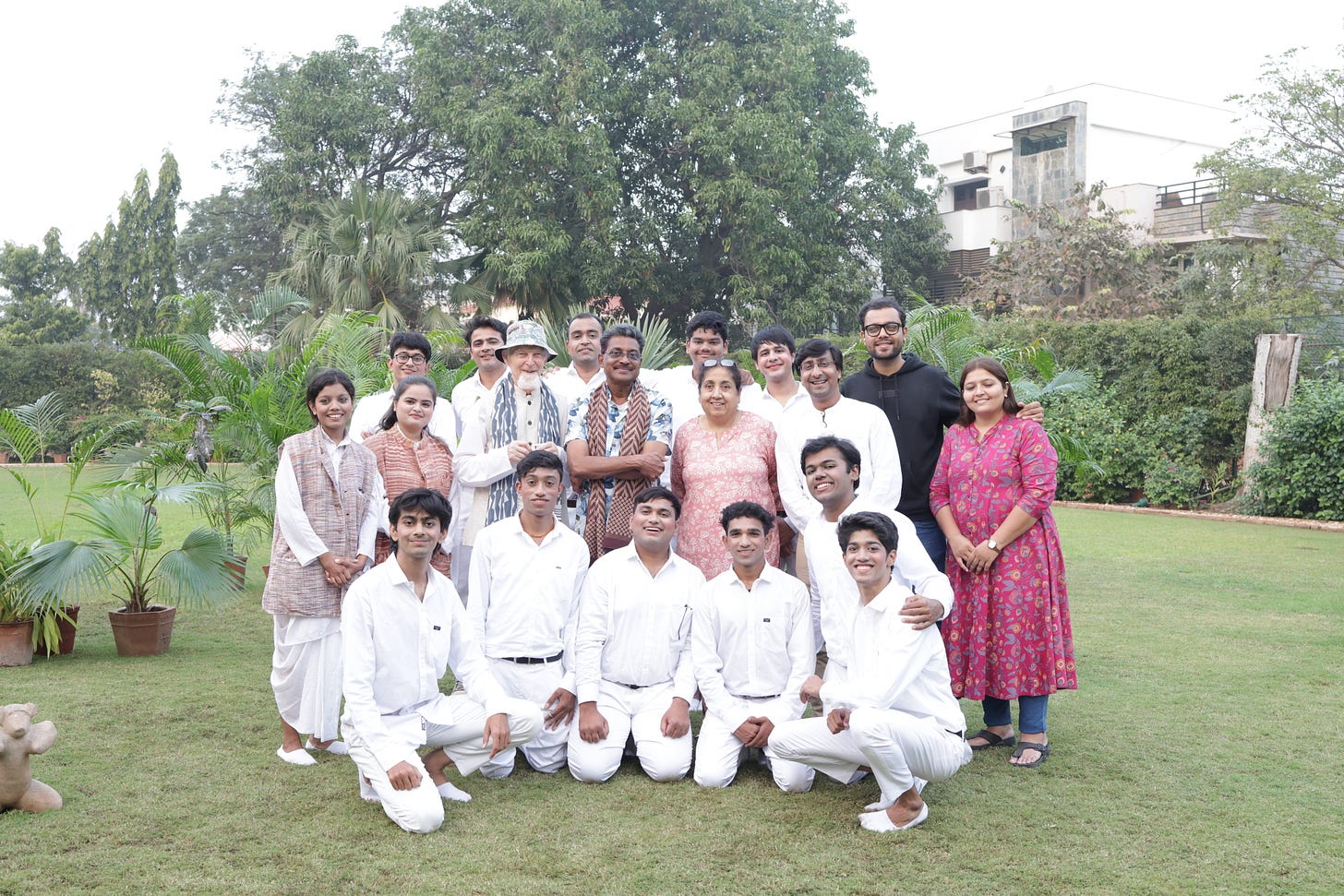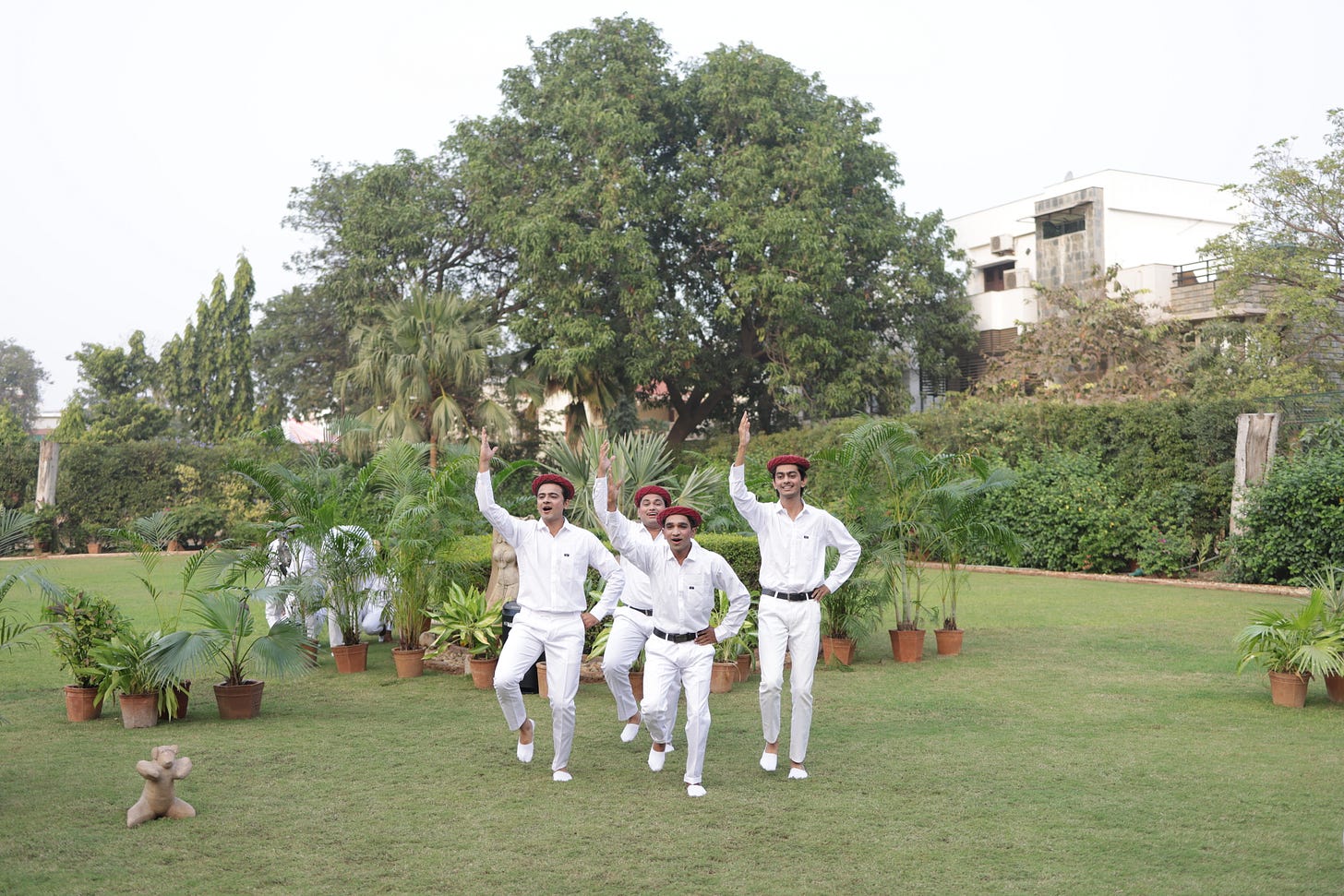The very talented Phanisari Chari has really been a gift to my small town that the town has unfortunately not really appreciated this the way it should. I saw his first play, Have you seen the Milky Way, back in 1985-86. Written by German playwright Karl Wittlinger, Chari worked with the English translation and presented it as his very impressive final year degree project for his studies in Theatre at the Faculty of Performing Arts, one of those rare occasions when a play in English was presented by its students. It was also staged by the German Language Society under late Dr. Srinivasan, at the Department of Foreign Languages, MSU.
Since then, of course, I have seen his directorial forays several times – experimenting with street theatre, presenting performances in English, Hindi, Gujarati and Marathi, working with school children as his cast, doing historical plays, regularly staging masala-mix full-length plays under the aegis of Triveni Theatre, teaching communication skills and the understanding of body language to journalism students by getting them up on stage and enacting different characters, and so on. And each time, he excelled himself, always bettering his skills and inputs, and I applauded heartily. And all the while, working assiduously and honestly at his job in the Syndicate Bank.
Phanisari Chari and Prof. John Drew (with scarves) with cast of Raas Mela. Photo by Umang Bhatt
Just as the last year turned over a new leaf a couple of weeks back, I saw another gem of a short play put together and directed by Chari that had the small but very appreciative audience cheering him on and breaking into peals of laughter over 45 minutes of the performance of Raas Mela. Since I had sort of commissioned this work, let me give you the background dope on the same. Many years back, I was introduced to Prof. John Drew by Prof. J. Birje-Patil, the former head of the English department when I was a student at the department. Prof. Drew is a poet, writer, dramatist, actor, academician and cricket historian and player – a Renaissance Man, in short. He came to the M S University as a young Commonwealth Scholar in the late 1960s-early 1970s, to be mentored in Theatre by Prof. C C Mehta (Chanchi), Professor Emeritus at the Faculty of Performing Arts. Of course, being from England, he also naturally gravitated towards the English department where Birje became a special friend. Drew’s profound interest in cricket was known to Chanchi, but Birje treated it as a kind of whimsicality which he hoped Drew would get over with (he didn’t!). Writes Drew in his recent piece in The Scroll, “Long ago, Chanchi Mehta, had handed me a copy of the Râs Mâlâ, a historical work from 1856 by the administrator Alexander Forbes, and he told me that the earliest known cricketing in the subcontinent had taken place somewhere on the Gulf of Cambay near his (Chanchi’s) native Surat. When I took up an interest in cricket again after more than 50 years out of it, I looked up old shipping records in London to see if I could make sense out of the fascinating but garbled narrative of the East India Company sailor, Clement Downing, who was on the spot and tells us about it”.
Drew went on a serious research spree, and determined almost exactly where the cricket was played -- on the banks of the River Dhadhar, near Cambay (Khambhat) and not Surat as Chanchi believed, for nearly a fortnight in the run-up to Christmas of 1721. The East India Company was all at sea on the west coast of India at this time, barely hanging on to ‘pestilential Bombay’, the crews of their country-built boats overwhelmingly Indian, with individual Englishmen, desperate to get out of England (advised, Go east, young man, in search of fame and fortune) only too happy to get employ with one or other of the contending Indian powers, Mughals or Maratha or whoever willing to offer a job. When Birje emailed me, more than a decade back, asking me to help Drew, who was shortly going to be again in Baroda, to find out where this space on the banks of the Dhadhar was or could be, then the game was afoot! While unfortunately, when Drew landed up, our dates could not match, but in the manner of the intrepid researcher, Drew braved forest and thorny weeds to reach what he thought was a probable site and even got himself photographed there. He went back home and wrote a small booklet, When Cricket first came to India. He got a few printed digitally and sent a copy to me. I was amazed at the dramatic possibilities of a story, which I think I mentioned to him casually. The next thing I know, I get an email from him with his text converted into a script of a play.
I shared that script with two friends, one after another, friends who were actually looking for scripts at that time for their drama initiatives with children. Within a couple of weeks, the script came back. Impossible! Too complicated! Not performable! These were the remarks, excuses. Then, out of the blue, came a call from Chari, talking about Kanasari, his newest production, based on an oral folk tale popular amongst the tribal community of the Dangs region in south Gujarat. And I, very selfishly, thrust upon him the Cricket script and asked him if he could check it out. Though he was extremely busy with Kanasari and taking it forward via competitions and performances across the country, not to forget that he fell very ill during the pandemic and it took him several months to get back on his feet, he did take the time to go through the script and get back to me. I found that very professional on his part, and quite touching, at a personal level. Even if he had said that the script was not very inspiring, I would still have appreciated his effort very sincerely.
Prof. John Drew chatting with members of the cast after the performance. Photo by Umang Bhatt.
But, and here’s the thing, he said he found the script interesting and that there was a competition in Scotland and another in Ahmedabad, where he could perhaps enter the play. In between his various busy schedules, he managed to re-organise and tighten the script and shot on video a certain part of the play that could be mailed to the competition for short-listing as was required. Chari’s crisp script went thus -- a British vessel of East India Company was stuck by low tide off the coast of Jambusar, and the next high tide was expected after a fortnight. During their incapacitation, the British crew got down to the shore and engaged the local population of the Kolis, the Persian Muslims, and the Maratha soldiers to play cricket with them. Later this population improvised and adapted the game to local conditions. That’s it – Chari kept the narrative short and simple. However, going beyond the text, Chari treated the play as an attempt to foreground stories of colonial relations, the violence between the Englishmen and locals that often obliterated such stories that happened in the backdrop.
Then, as the last year was galloping to its end, I got an email from Drew about his intended visit to India post-Christmas, and could he drop by in Baroda and take a look at what Chari has done? Knowing Chari’s tough schedule, I insisted that he just present whatever he had directed in the video clip and leave it at that. We would present it like a street play and the lawns of the Navrachana guest house provided everything that Chari wanted.
And then he did the unexpected. He presented the whole play in less than 45 minutes. A long sheet of fabric doubled as the Dhadhar river and the wicket. All the actors wore white trousers, shirts and socks with their headgear changing from time to time to indicate Kolis, Gaekwadi Marathas, Englishmen, cricketers, local traders and so on. The play was presented in desi English, the songs set to the lilting sing-song of the vernacular accent.
A dramatic moment in the play — the fighting Kolis! Photo by Umang Bhatt.
Let me now share what Drew has to say. On January 2, on the campus of a school in Vadodara, a company of a dozen actors, directed by Panisari Chari of the local Triveni Theatre, used traditional Gujarati dance forms to recreate the story of the first-known game of cricket on Indian soil – in 1721. Little interest was shown in this story when it was published and eventually, as a personal tribute to my old teacher Chanchi, I worked up a dance drama out of the story, using the dandiya râs. The tercentenary of the cricket match passed (in 2021), Covid struck, and then, with last year’s ODI World Cup approaching, director Panisai Chari workshopped a Gujarati version of the play.
Chari transformed my script out of all recognition, its choreography utterly enchanting. Since I was hoping to make a final family visit to India over the New Year, he promised to show me a scene or two. To my delight and surprise, when we came to see the re-enactment, it was performed not, as expected, in Gujarati but in English. Wearing diversely coloured hats, the actors represented in turn the different communities struggling to claim the cotton fields around Jambusar in the early 18th century.
The Gaekwadi Maratha headgear identifies this community. Photo by Umang Bhatt.
The dances dramatised how the Mughal satrap Rustam Ali Khan was being put on the back foot by the rising power of the Marathas and how both took over the fields actually cultivated by the maligned Kolis. The play, shows the crews of a couple of Company ships docking beside the mango and tamarind groves on the Dhadar River. The largely Bombay Koli crews expect to be attacked by marauding Kolis from the River Mahi district but are surprised to find that when they land to play some cricket and keep themselves in shape, the local people come to watch them, curious to work out what sort of military exercise cricket is.
This unexpectedly peaceful response leads to a comic scene where a couple of Company sailors try to trade for Christmas provisions with a local sarpanch. After much confusion and haggling via two translators, they are so fleeced in paying Rs 20 each for bullocks and Rs 2 each for sheep that the headman kindly gives them a dozen chicken for free.
Cricket as it was first played 300 years back! Photo by Umang Bhatt.
The play ends with the ship’s tindal or bosun running, to the applause of the audience, 13 runs – there were no boundaries in those days – and the actors donning masks of contemporary Indian cricketers to remind us how far the game has come since its hitherto overlooked origins 300 years ago. Sutradhar Chanda Mama, acted by two young women, was a covert reference and tribute to Chandravadan Mehta – my teacher, Chari’s examiner and Sandhya Gajjar’s friend alike. As Sandhya commented, “While we all honour Virat, there is far too little interest in our local history of the earlier cricketing Kolis.”
John Drew: How a Gujarati dance drama recreated the first known game of cricket on Indian soil in 1721; online printed in Scroll, dated January 14, 2024, 11.30 am









What a wonderful outcome of three persistent people and a few enthusiastic students! Wish we could have witnessed this performance! I've seen Mr Chari work wonders with the Journalism students, while I was teaching there.
PS Chari is a multifaceted personality. Had an opportunity to be a part of his acting workshop.
His energy is infectious. He is an asset to Vadodara. More power to Triveni !!